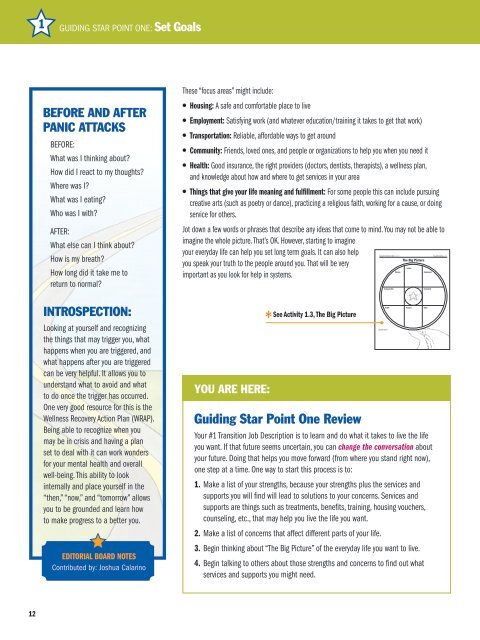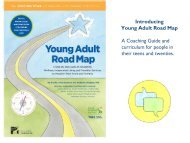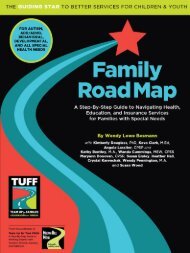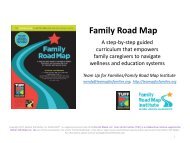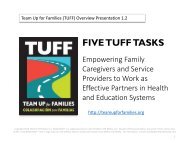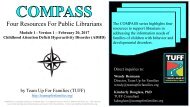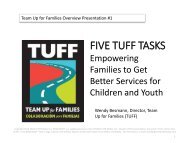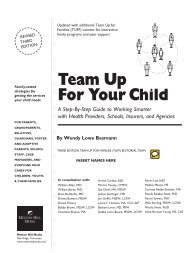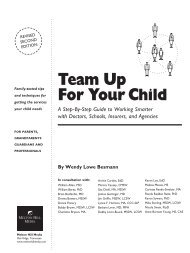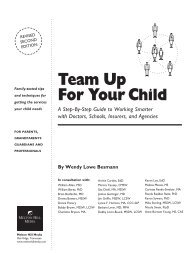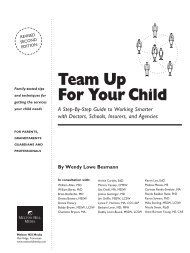Look Inside Young Adult Road Map
Create successful ePaper yourself
Turn your PDF publications into a flip-book with our unique Google optimized e-Paper software.
Guiding Star Point One: Set GOAL Activity 1.3<br />
<strong>Young</strong> <strong>Adult</strong> <strong>Road</strong> <strong>Map</strong>, page xx<br />
1<br />
Guiding Star Point one: Set Goals<br />
Before and after<br />
panic attacks<br />
Before:<br />
What was I thinking about?<br />
How did I react to my thoughts?<br />
Where was I?<br />
What was I eating?<br />
Who was I with?<br />
After:<br />
What else can I think about?<br />
How is my breath?<br />
How long did it take me to<br />
return to normal?<br />
Introspection:<br />
<strong>Look</strong>ing at yourself and recognizing<br />
the things that may trigger you, what<br />
happens when you are triggered, and<br />
what happens after you are triggered<br />
can be very helpful. It allows you to<br />
understand what to avoid and what<br />
to do once the trigger has occurred.<br />
One very good resource for this is the<br />
Wellness Recovery Action Plan (WRAP).<br />
Being able to recognize when you<br />
may be in crisis and having a plan<br />
set to deal with it can work wonders<br />
for your mental health and overall<br />
well-being. This ability to look<br />
internally and place yourself in the<br />
“then,” “now,” and “tomorrow” allows<br />
you to be grounded and learn how<br />
to make progress to a better you.<br />
Editorial Board Notes<br />
Contributed by: Joshua Calarino<br />
These “focus areas” might include:<br />
l Housing: A safe and comfortable place to live<br />
l Employment: Satisfying work (and whatever education/training it takes to get that work)<br />
l Transportation: Reliable, affordable ways to get around<br />
l Community: Friends, loved ones, and people or organizations to help you when you need it<br />
l Health: Good insurance, the right providers (doctors, dentists, therapists), a wellness plan,<br />
and knowledge about how and where to get services in your area<br />
l Things that give your life meaning and fulfillment: For some people this can include pursuing<br />
creative arts (such as poetry or dance), practicing a religious faith, working for a cause, or doing<br />
service for others.<br />
Jot down a few words or phrases that describe any ideas that come to mind. You may not be able to<br />
imagine the whole picture. That’s OK. However, starting to imagine<br />
your everyday life can help you set long term goals. It can also help<br />
The Big Picture<br />
you speak your truth to the people around you. That will be very<br />
Leisure<br />
Housing<br />
Employment<br />
important as you look for help in systems.<br />
Transportation<br />
Community<br />
*<br />
Health<br />
Purpose<br />
Other<br />
See Activity 1.3, The Big Picture<br />
You are here:<br />
Guiding Star Point One Review<br />
Your #1 Transition Job Description is to learn and do what it takes to live the life<br />
you want. If that future seems uncertain, you can change the conversation about<br />
your future. Doing that helps you move forward (from where you stand right now),<br />
one step at a time. One way to start this process is to:<br />
1. Make a list of your strengths, because your strengths plus the services and<br />
supports you will find will lead to solutions to your concerns. Services and<br />
supports are things such as treatments, benefits, training, housing vouchers,<br />
counseling, etc., that may help you live the life you want.<br />
2. Make a list of concerns that affect different parts of your life.<br />
3. Begin thinking about “The Big Picture” of the everyday life you want to live.<br />
4. Begin talking to others about those strengths and concerns to find out what<br />
services and supports you might need.<br />
Any text here?<br />
12


